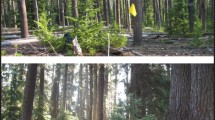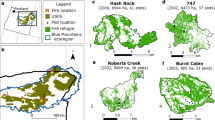Abstract
The pine rocklands of southern Florida are a fire-dependent forest associated with outcroppings of limestone. Pine rockland plants have several adaptations to fire, and for many species burns increase plant growth, flowering, and seedling establishment. The pine rockland forest has been reduced and fragmented in recent decades. Outside of Everglades National Park, only two percent of the original pine rocklands remain, and are in the form of small fragments. Habitat fragmentation may have a negative effect on the biology of plants; we investigated the effects of both fire and fragmentation on Angadenia berteroi (A.DC.) Miers, a threatened species of the southern Florida pine rockland. We estimated the density and flowering of A. berteroi using adaptive cluster sampling in six study sites with different fire and disturbance histories. A. berteroi is more abundant in the largest fragments, and those having experienced fire most recently. However, fragmentation and lack of fire did not appear to have a great impact on flowering or fruit production. Insights from this threatened species may provide impetus not only to conserve, but to properly manage remaining pine rocklands in south Florida.




Similar content being viewed by others
References
Artz DR, Waddington KD (2006) The effects of neighbouring tree islands on pollinator density and diversity, and on pollination of a wet prairie species, Asclepias lanceolata (Apocynaceae). J Ecol 94:597–608
Barrios B, Koptur S (2011) Floral biology and breeding system of Angadenia berteroi (Apocynaceae): why do flowers of the pineland golden trumpet produce few fruits? Int J Plant Sci (in press)
Borchert M, Tyler CM (2009) Patterns of post-fire flowering and fruiting in Chlorogalum pomeridianum var pomeridianum (DC.) Kunth in southern California chaparral. Int J Wildl Fire 18:623–630
Cardel YJ, Koptur S (2010) Effects of florivory on the pollination of flowers: an experimental field study with a perennial plant. Int J Plant Sci 171:283–292
Cochrane MA (2001) Synergistic interactions between habitat fragmentation and fire in evergreen tropical forests. Conserv Biol 15:1515–1521
Cochrane MA, Schulze MD (1999) Fire as a recurrent event in tropical forests of the eastern Amazon: effects on forest structure, biomass, and species composition. Biotropica 31:2–16
Dellasala DA, Williams JE, Williams CD, Franklin JE (2004) Beyond smoke and mirrors: a synthesis of fire policy and science. Conserv Biol 18:976–986
DiTommaso A, Clements DR, Darbyshire SJ, Dauer JT (2009) The biology of Canadian weeds. 143. Apocynum cannabinum L. Can J Plant Sci 89:977–992
Gann GD, Bradley KA, Woodmansee SW (2002) Rare plants of South Florida: their history, conservation, and restoration. Institute for Regional Conservation, Miami
Geiger JH (2002) The reproductive biology of Ruellia succulenta (Acanthaceae) and the effects of habitat fragmentation. Master of Science. Florida International University, Miami
Harrod RJ, Halpern CB (2009) Effects of experimental burning on individual performance and population structure of two rare plants of northcentral Washington. Restor Ecol 17:215–225
Hiers JK, Wyatt R, Mitchell RJ (2000) The effects of fire regime on legume reproduction in longleaf pine savannas: is a season selective? Oecologia 125:521–530
Hiers JK, O’Brien J, Will RE, Mitchell RJ (2007) Forest floor depth mediates understory vigor in xeric Pinus palustris ecosystems. Ecol Appl 17:806–814
Johnson SA, Bruederle LP, Tomback DF (1998) A mating system conundrum: hybridization in Apocynum (Apocynaceae). Am J Bot 85:1316–1323
Kirkman LK, Mitchell RJ, Helton RC, Drew MB (2001) Productivity and species richness across an environmental gradient in a fire-dependent ecosystem. Am J Bot 88:2119–2128
Koptur S (2006) The conservation of specialized and generalized pollination systems in subtropical ecosystems: a case study. In: Waser N, Ollerton J (eds) Plant–pollinator interactions: from specialization to generalization. University of Chicago Press, Chicago, pp 341–361
Krings A (2006) Distribution and phenology of Gonolobus suberosus (Apocynaceae, Asclepiadoideae) and its varieties in North America. Vulpia 5:23–40
Liu H, Menges ES, Quintana-Ascencio PF (2005a) Population viability analyses of Chamaecrista keyensis: effects of fire season and frequency. Ecol Appl 15:210–221
Liu H, Menges ES, Snyder JR, Koptur S, Ross MS (2005b) Effects of fire intensity on vital rates of an endemic herb of the Florida Keys, USA. Nat Areas J 25:71–76
Long RW, Lakela O (1978) A flora of tropical Florida. The University of Miami Press, Miami
Margules CR, Pressey RL (2000) Systematic conservation planning. Nature 405:243–253
Moreno JM, Oechel WC (1991) Fire intensity effects on germination of shrubs and herbs in southern California chaparral. Ecology 72:1993–2004
Natural Areas Management, Miami-Dade County (2008) WILDFIRE Excel spreadsheet—fire history of managed areas, 1975–2008
O’Brien JJ (1998) The distribution and habitat preferences of rare Galactia species (Fabaceae) and Chamaesyce deltoidea subspecies (Euphorbiaceae) native to southern Florida pine rockland. Nat Areas J 18:208–222
Philippi T (2005) Adaptive cluster sampling for estimation of abundances within local populations of low abundance plants. Ecology 85:1091–1100
Possley J, Woodmansee SW, Maschinski J (2008) Patterns of plant composition in fragments of globally imperiled pine rockland forest: effects of soil type, recent fire frequency, and fragment size. Nat Areas J 28:379–394
SAS Institute Inc. (2003) SAS 9.1 for Windows. SAS Institute Inc., Cary
Sloan SA, Zimmerman JK, Sabat AM (2007) Phenology of Plumeria alba and its herbivores in a tropical dry forest. Biotropica 39:195–201
Snyder JR, Herndon A, Robertson WB (1990) South Florida rockland. In: Myers R, Ewel J (eds) Ecosystems of Florida. University of Central Florida Press, Orlando, pp 230–277
Spier LP, Snyder JR (1998) Effects of wet- and dry-season fires on Jacquemontia curtisii, a South Florida pine forest endemic. Nat Areas J 18:350–357
SPSS Inc. (2009) SPSS 17 for Windows. SPSS Inc., Chicago
Thompson SK (1990) Adaptive cluster sampling. J Am Stat Assoc 85:1050–1059
Thompson SK, Seber GAF (1994) Detectability in conventional and adaptive sampling. Biometrics 50:712–724
Thompson SK, Seber GAF (1996) Adaptive sampling. Wiley, New York
Torres C, Galetto L (1999) Factors constraining fruit set in Mandevilla pentlandiana (Apocynaceae). Bot J Linn Soc 129:187–205
U.S. Fish and Wildlife Service (1999) South Florida multi-species recovery plan. U.S. Fish and Wildlife Service, Atlanta
Wendelberger KS, Maschinski J (2009) Linking geographical information systems and observational and experimental studies to determine optimal seedling microsites of an endangered plant in a subtropical urban fire-adapted ecosystem. Restor Ecol 17:845–853
Whelan RJ (1995) The ecology of fire. Cambridge University Press, Cambridge
Wrobleski DW, Kauffman JB (2003) Initial effects of prescribed fire on morphology, abundance, and phenology of forbs in big sagebrush communities in southeastern Oregon. Restor Ecol 11:82–90
Wunderlin RP, Hansen BF (2003) Guide to the vascular plants of Florida, 2nd edn. University Press of Florida, Gainesville
Yates CJ, Ladd PG (2005) Relative importance of reproductive biology and establishment ecology for persistence of a rare shrub in a fragmented landscape. Conserv Biol 19:239–249
Acknowledgments
We thank Jennifer Richards, Mike Ross, and Jim Snyder for their constructive input during the course of this research and writing of the findings. Manuscript clarity was also improved by John Geiger, Jay Sah, and two anonymous reviewers. We thank Jay Sah and Tom Philippi for their statistical advice. Rafael Travieso provided help with Fig. 1. Isabel Rodriquez, Kenny Lo, Soraya Allahar, Adel Peña, Michelle Barragan, and Ayo Jolibois provided help in the field. Funding was provided to Beyte Barrios by The Florida Native Plant Society (2008 Endowment Research Grant); FIU Kelly Scholarships (2008, 2009); and a Catherine H. Beattie Fellowship (2009) from The Garden Club of America. Collections were made under permit # 0080 from Natural Areas Management (Miami-Dade County), and Everglades National Park Scientific Research and Collection permit # EVER-2008-SCI-0070. This is contribution #195 to the Tropical Biology Program at Florida International University.
Author information
Authors and Affiliations
Corresponding author
Rights and permissions
About this article
Cite this article
Barrios, B., Arellano, G. & Koptur, S. The effects of fire and fragmentation on occurrence and flowering of a rare perennial plant. Plant Ecol 212, 1057–1067 (2011). https://doi.org/10.1007/s11258-010-9886-7
Received:
Accepted:
Published:
Issue Date:
DOI: https://doi.org/10.1007/s11258-010-9886-7




